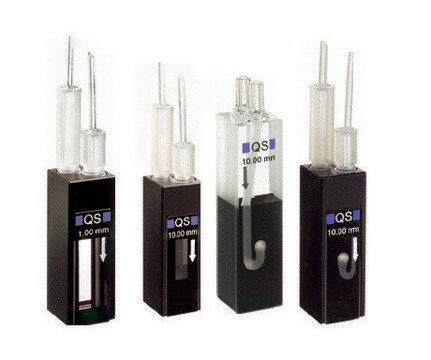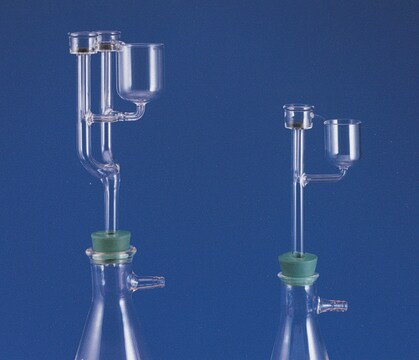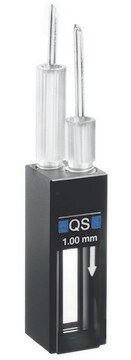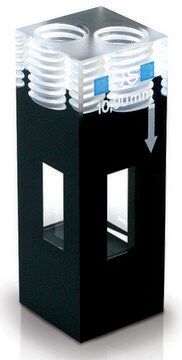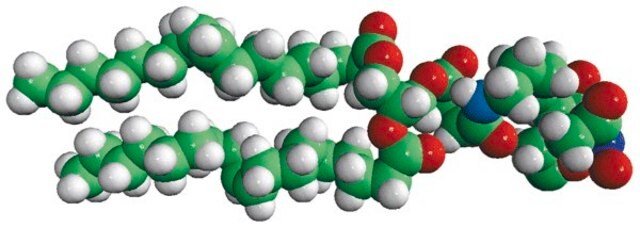Z805939
Hellmanex™ III
Special Cleaning Concentrate for cuvettes
Sinónimos:
III-Grade Laboratory Detergent
Iniciar sesiónpara Ver la Fijación de precios por contrato y de la organización
About This Item
UNSPSC Code:
12000000
NACRES:
SB.32
Productos recomendados
packaging
pkg of 1 L (PE bottle)
manufacturer/tradename
Hellma
technique(s)
UV/Vis spectroscopy: suitable
photometry: suitable
General description
Hellmanex III significantly reduces the surface tension of water. The removal of dirt particles is also assured by the good wetting action of a Hellmanex III aqueous solution, while its high emulsifying and dispersing capabilities prevent the redeposition of the loosened particles. Special surface-active substances facilitate the residue-free rinsing of the optical components once they have been cleaned.
Hellmanex III is filtered to 1 μm and is therefore virtually free of solid particles.
Hellmanex III is filtered to 1 μm and is therefore virtually free of solid particles.
Application
The optimal dilution (usually 0.5 to 2 vol-%) depends on several factors, such as the hardness of the water, the degree and type of contamination, the temperature, etc. The use of demineralised water improves the cleaning characteristics.
An increase in temperature speeds up the cleaning process. However, at high temperatures it is necessary to avoid thermal shock. The cells should be pre-warmed before being submerged into hot cleaning solutions.
Hellmanex III, when diluted to its working concentration of 2%, is suitable for use with glass, quartz, sapphire, porcelain, ceramics, plastics, and ferrous metals. It can also be used, with some limitations, on metals that are sensitive to corrosion such as aluminium and other non-ferrous metals. In such cases, avoid prolonged application. In the case of materials not listed here, suitability tests should be carried out or enquiries directed to Hellma.
The concentrate can be stored in vessels made of stainless steel, PE, PP, PVC, FPM, or NBR.
An increase in temperature speeds up the cleaning process. However, at high temperatures it is necessary to avoid thermal shock. The cells should be pre-warmed before being submerged into hot cleaning solutions.
Hellmanex III, when diluted to its working concentration of 2%, is suitable for use with glass, quartz, sapphire, porcelain, ceramics, plastics, and ferrous metals. It can also be used, with some limitations, on metals that are sensitive to corrosion such as aluminium and other non-ferrous metals. In such cases, avoid prolonged application. In the case of materials not listed here, suitability tests should be carried out or enquiries directed to Hellma.
The concentrate can be stored in vessels made of stainless steel, PE, PP, PVC, FPM, or NBR.
Legal Information
Hellmanex is a trademark of Hellma GmbH
signalword
Danger
hcodes
Hazard Classifications
Eye Dam. 1 - STOT SE 3
target_organs
Respiratory system
Storage Class
12 - Non Combustible Liquids
wgk_germany
WGK 1
flash_point_f
Not applicable
flash_point_c
Not applicable
Elija entre una de las versiones más recientes:
Certificados de análisis (COA)
Lot/Batch Number
Lo sentimos, en este momento no disponemos de COAs para este producto en línea.
Si necesita más asistencia, póngase en contacto con Atención al cliente
¿Ya tiene este producto?
Encuentre la documentación para los productos que ha comprado recientemente en la Biblioteca de documentos.
Los clientes también vieron
Stefan Niekamp et al.
The EMBO journal, 38(13), e101414-e101414 (2019-07-04)
The movement of a molecular motor protein along a cytoskeletal track requires communication between enzymatic, polymer-binding, and mechanical elements. Such communication is particularly complex and not well understood in the dynein motor, an ATPase that is comprised of a ring
Doug K Tischer et al.
eLife, 8 (2019-04-06)
T cells are thought to discriminate self from foreign peptides by converting small differences in ligand binding half-life into large changes in cell signaling. Such a kinetic proofreading model has been difficult to test directly, as existing methods of altering
Stefan Niekamp et al.
Proceedings of the National Academy of Sciences of the United States of America, 116(10), 4275-4284 (2019-02-17)
Light microscopy is a powerful tool for probing the conformations of molecular machines at the single-molecule level. Single-molecule Förster resonance energy transfer can measure intramolecular distance changes of single molecules in the range of 2 to 8 nm. However, current
Nuestro equipo de científicos tiene experiencia en todas las áreas de investigación: Ciencias de la vida, Ciencia de los materiales, Síntesis química, Cromatografía, Analítica y muchas otras.
Póngase en contacto con el Servicio técnico
